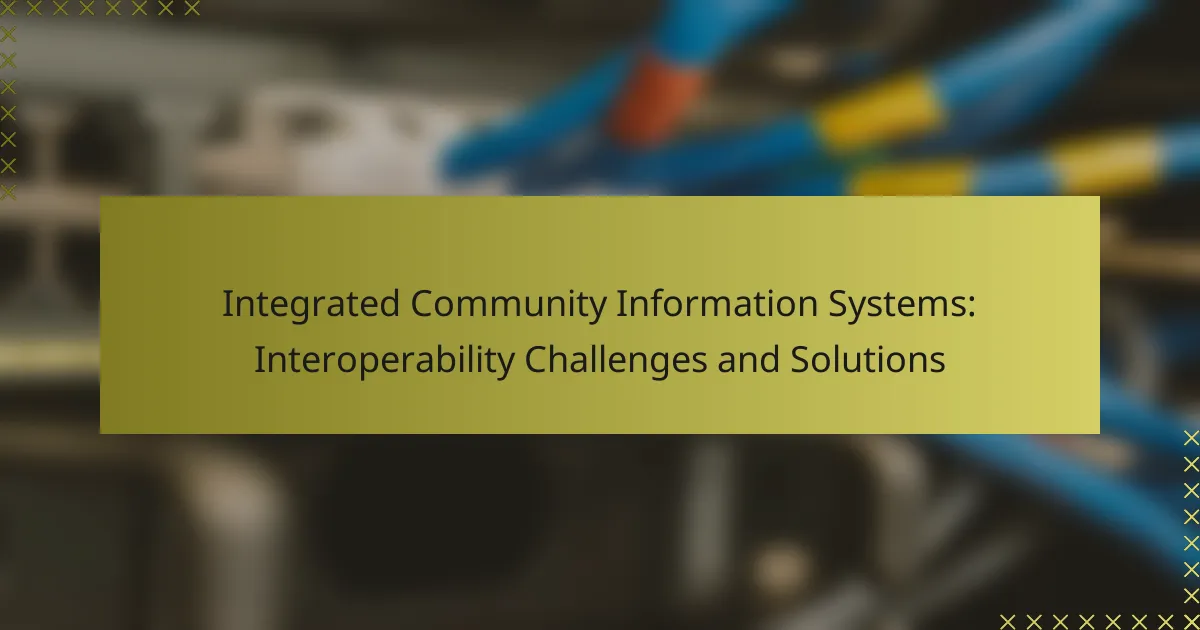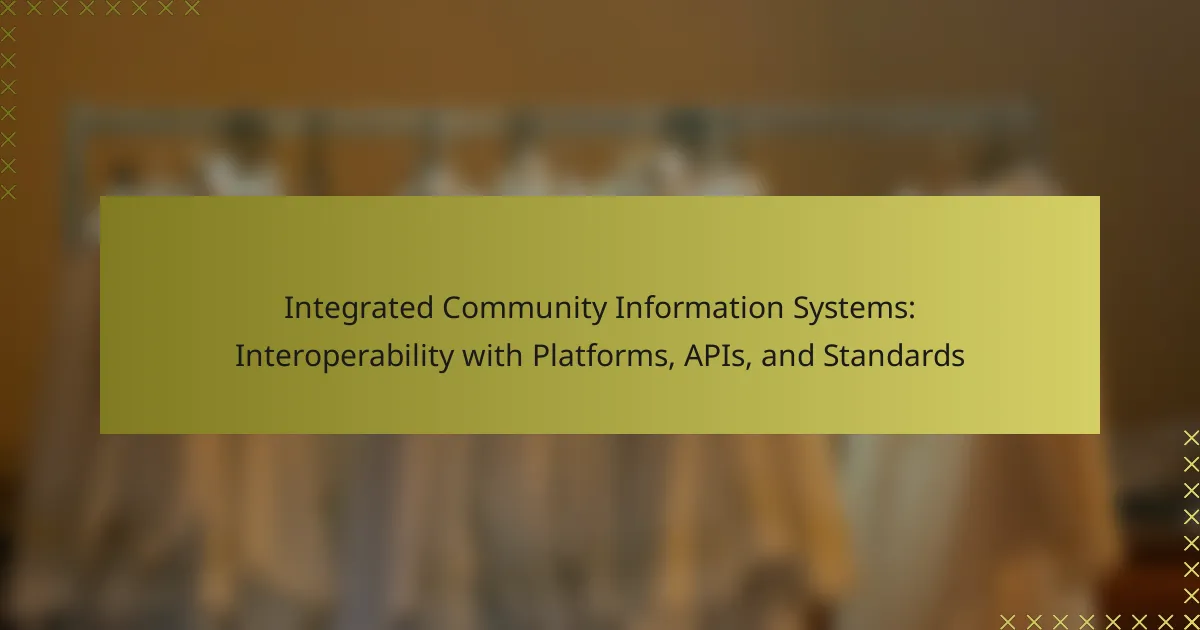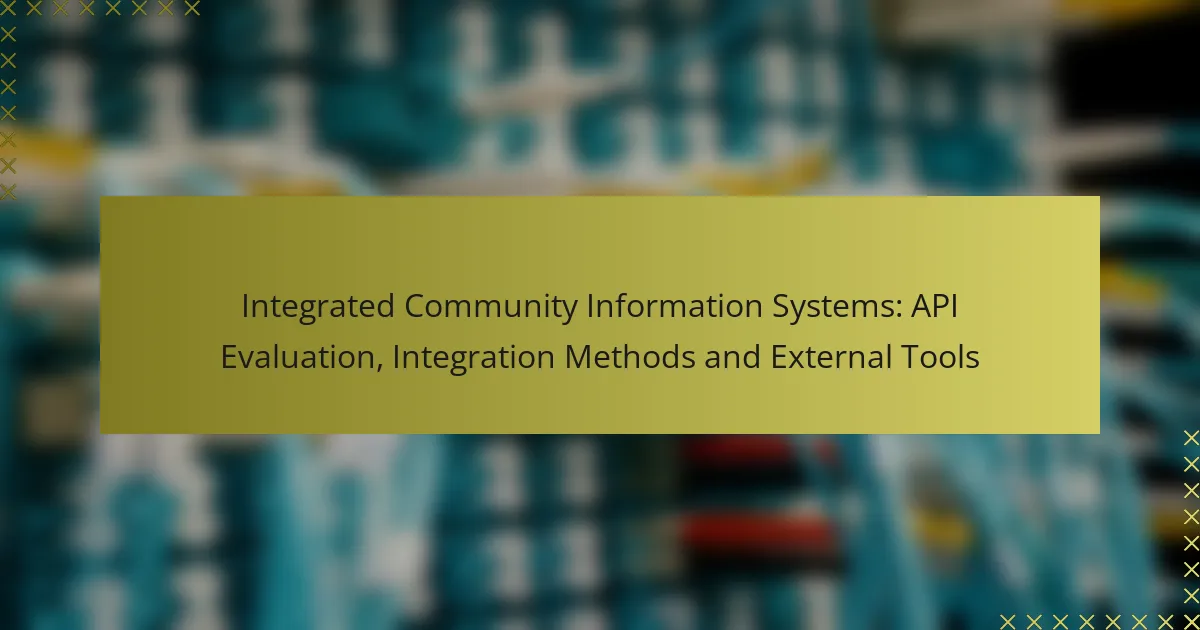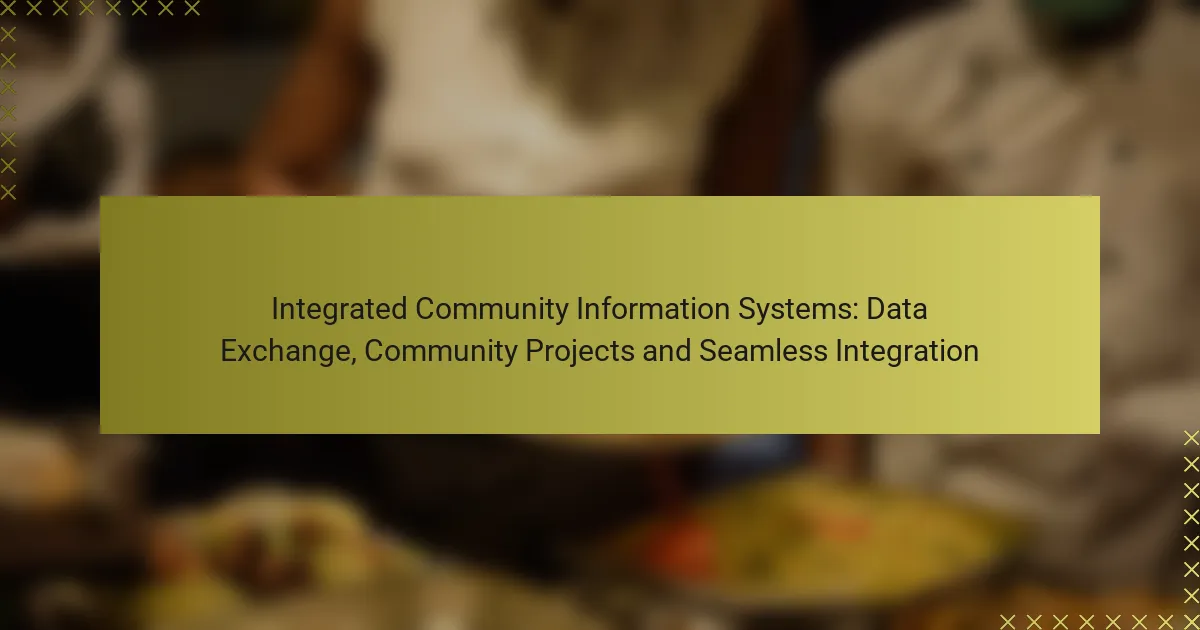Integrated Community Information Systems (ICIS) face significant interoperability challenges that impede data exchange and communication among diverse systems. These obstacles can adversely affect information sharing, service delivery, and community engagement. To overcome these challenges, a strategic approach involving open standards, API frameworks, and stakeholder engagement is essential for ensuring seamless data flow and effective communication across platforms.

What are the interoperability challenges in Integrated Community Information Systems?
Interoperability challenges in Integrated Community Information Systems (ICIS) primarily involve difficulties in data exchange and communication between different systems. These challenges can hinder the effective sharing of information, ultimately impacting service delivery and community engagement.
Data standardization issues
Data standardization issues arise when different systems use varying formats, terminologies, and protocols, making it difficult to share and interpret information consistently. For example, one system might use “DOB” for date of birth while another uses “Birthdate,” leading to confusion and errors in data processing.
To address these issues, stakeholders should adopt widely accepted data standards, such as HL7 or FHIR in healthcare contexts, which facilitate smoother data integration. Regular audits and updates of data formats can also help maintain consistency across systems.
Legacy system integration
Legacy system integration poses significant challenges as older systems may not support modern interoperability standards or technologies. These systems often require substantial modifications or complete replacements, which can be costly and time-consuming.
Organizations can mitigate these challenges by gradually phasing in new systems while ensuring that legacy systems can still communicate with newer technologies. Utilizing middleware solutions can also bridge the gap between old and new systems, allowing for better data flow.
Privacy and security concerns
Privacy and security concerns are critical when integrating community information systems, as sensitive data must be protected from unauthorized access. Compliance with regulations such as GDPR in Europe or HIPAA in the United States is essential to safeguard personal information.
To enhance security, organizations should implement robust encryption methods, conduct regular security audits, and provide training for staff on data protection best practices. Establishing clear data access policies can also help mitigate risks associated with data breaches.
Lack of stakeholder collaboration
A lack of stakeholder collaboration can severely limit the effectiveness of Integrated Community Information Systems. When different organizations or departments do not communicate or share goals, it can lead to fragmented systems that do not work well together.
To foster collaboration, stakeholders should engage in regular meetings and workshops to align their objectives and share insights. Creating a governance framework that includes representatives from all relevant parties can also facilitate better coordination and decision-making.
Resource constraints
Resource constraints, including limited budgets and personnel, can hinder the development and maintenance of interoperable systems. Many organizations struggle to allocate sufficient funds for technology upgrades or staff training, impacting overall system effectiveness.
To overcome these constraints, organizations should prioritize their interoperability goals and seek funding opportunities through grants or partnerships. Leveraging open-source solutions can also reduce costs while providing access to necessary tools and resources for system integration.

What are the best practices for achieving interoperability?
Achieving interoperability in Integrated Community Information Systems requires a strategic approach that includes adopting open standards, implementing API frameworks, engaging community stakeholders, and utilizing cloud-based solutions. These practices help ensure that different systems can communicate effectively and share data seamlessly.
Adopting open standards
Open standards are essential for interoperability as they provide a common framework that different systems can use to communicate. By adhering to widely accepted standards, organizations can reduce compatibility issues and facilitate easier data exchange. Examples of open standards include XML, JSON, and HL7 for health information systems.
When adopting open standards, consider the specific needs of your community and the types of data being shared. Collaborating with other organizations to establish these standards can lead to more cohesive systems and better overall outcomes.
Implementing API frameworks
API frameworks enable different software applications to interact with each other, making them crucial for interoperability. By implementing robust APIs, organizations can allow for real-time data sharing and integration between various systems. This can enhance service delivery and improve user experiences.
Choose API frameworks that are flexible and scalable to accommodate future needs. Ensure that proper documentation is available to facilitate easier integration and maintenance. Common frameworks include RESTful APIs and GraphQL.
Engaging community stakeholders
Engaging community stakeholders is vital for achieving interoperability as it ensures that the systems developed meet the actual needs of users. Involving stakeholders from the beginning can lead to better alignment of goals and expectations, ultimately resulting in more effective systems.
Organize workshops and meetings to gather input from various stakeholders, including government agencies, non-profits, and community members. This collaborative approach can help identify potential challenges and foster a sense of ownership among users.
Utilizing cloud-based solutions
Cloud-based solutions offer scalability and flexibility, making them an excellent choice for achieving interoperability. These solutions can facilitate easier data sharing and integration across different platforms while reducing the need for extensive on-premises infrastructure.
When selecting cloud-based solutions, consider factors such as data security, compliance with local regulations, and the ability to integrate with existing systems. Popular options include Microsoft Azure, Amazon Web Services, and Google Cloud Platform, which provide various tools for interoperability.

How can technology facilitate interoperability?
Technology can significantly enhance interoperability by enabling different systems to communicate and share data seamlessly. This is achieved through various solutions that bridge gaps between disparate systems, ensuring that information flows efficiently and accurately across platforms.
Use of middleware solutions
Middleware solutions act as intermediaries that facilitate communication between different software applications. They help standardize data formats and protocols, allowing systems with varying architectures to work together. For instance, a healthcare system using middleware can integrate patient records from multiple providers, enhancing care coordination.
When implementing middleware, consider factors such as scalability and compatibility with existing systems. Selecting a robust middleware solution can minimize integration costs and reduce the time needed for system upgrades.
Integration platforms like MuleSoft
Integration platforms, such as MuleSoft, provide comprehensive tools for connecting applications, data, and devices. These platforms offer pre-built connectors and templates that simplify the integration process, making it easier for organizations to achieve interoperability. For example, a city government can use MuleSoft to connect its various public service applications, streamlining citizen access to services.
Choosing an integration platform requires evaluating your organization’s specific needs, including the types of applications in use and the volume of data exchanged. A well-chosen platform can significantly enhance operational efficiency and reduce integration time.
Data exchange protocols
Data exchange protocols define the rules and standards for how data is transmitted between systems. Common protocols, such as RESTful APIs and SOAP, ensure that data is exchanged in a consistent and reliable manner. For example, using RESTful APIs can allow different systems to share real-time data, improving decision-making processes.
When selecting data exchange protocols, consider the security implications and the complexity of implementation. Adopting widely accepted protocols can enhance interoperability while ensuring compliance with industry standards and regulations.

What role do policies play in interoperability?
Policies are crucial for ensuring interoperability among integrated community information systems by providing a structured framework that guides data sharing and communication. They establish standards and protocols that facilitate seamless interactions between different systems, ultimately enhancing service delivery and collaboration.
Establishing governance frameworks
Governance frameworks are essential for overseeing interoperability efforts, as they define roles, responsibilities, and decision-making processes. A well-structured governance model can include stakeholders from various sectors, such as government agencies, non-profits, and private organizations, ensuring that all perspectives are considered.
To create an effective governance framework, organizations should focus on establishing clear communication channels and regular meetings to discuss interoperability challenges. This collaborative approach can help identify best practices and foster a culture of shared responsibility among stakeholders.
Regulatory compliance requirements
Regulatory compliance is a key factor in achieving interoperability, as it ensures that systems adhere to established laws and standards. Organizations must be aware of relevant regulations, such as data protection laws, which can vary significantly by region and impact how information is shared.
To navigate compliance requirements effectively, organizations should conduct regular audits and assessments of their systems to ensure they meet legal obligations. Additionally, staying informed about changes in regulations can help organizations adapt their interoperability strategies accordingly, minimizing risks and enhancing collaboration.

What are the case studies of successful integration?
Successful integration of community information systems can be observed in various case studies that highlight effective interoperability solutions. These examples illustrate how different municipalities have tackled the challenges of data sharing and system compatibility.
City of San Diego’s data integration
The City of San Diego has implemented a robust data integration strategy that connects various city departments and services. By utilizing a centralized data platform, the city enables real-time access to information, improving decision-making and service delivery.
Key to this integration is the use of open data standards, which facilitate seamless communication between different systems. This approach not only enhances operational efficiency but also promotes transparency and public engagement.
Toronto’s community health information system
Toronto’s community health information system exemplifies successful integration in the healthcare sector. This system connects hospitals, clinics, and public health agencies, allowing for comprehensive patient data sharing and coordinated care.
By adopting interoperable health information exchange standards, Toronto has improved patient outcomes and reduced redundancies in care. The system also emphasizes data privacy and security, ensuring compliance with local regulations while fostering collaboration among healthcare providers.

What are the emerging trends in Integrated Community Information Systems?
Emerging trends in Integrated Community Information Systems (ICIS) focus on enhancing interoperability, user engagement, and data-driven decision-making. These systems are evolving to better connect various community services and improve access to information for both providers and users.
Increased focus on interoperability standards
Interoperability standards are becoming crucial as communities seek to integrate various information systems effectively. These standards facilitate seamless data exchange between different platforms, ensuring that information is accessible and usable across multiple services.
Communities are adopting frameworks like HL7 for health data and the Open Geospatial Consortium standards for geographic information. Implementing these standards can significantly reduce data silos and improve service delivery.
Emphasis on user-centered design
User-centered design is gaining traction in the development of Integrated Community Information Systems. By prioritizing the needs and experiences of end-users, these systems can become more intuitive and effective.
Engaging with community members during the design process helps identify specific needs and preferences. This approach can lead to higher adoption rates and better overall satisfaction with the services provided.
Utilization of advanced analytics
Advanced analytics are increasingly being utilized within Integrated Community Information Systems to drive insights and improve decision-making. By leveraging data analytics, communities can identify trends, assess needs, and allocate resources more effectively.
For example, predictive analytics can help forecast service demand, allowing for proactive adjustments in staffing or resource allocation. Communities can also use data visualization tools to present information clearly to stakeholders.
Integration of mobile technologies
The integration of mobile technologies is transforming how Integrated Community Information Systems operate. Mobile applications enable users to access information and services on-the-go, enhancing convenience and engagement.
Communities are developing mobile-friendly platforms that allow users to report issues, access services, and receive updates in real-time. This shift not only improves user experience but also fosters greater community involvement.
Collaboration across sectors
Collaboration across various sectors is becoming essential for the success of Integrated Community Information Systems. Partnerships between government agencies, non-profits, and private organizations can enhance resource sharing and service delivery.
By working together, these entities can create a more comprehensive support network for community members. Joint initiatives can lead to innovative solutions that address complex social issues more effectively.



